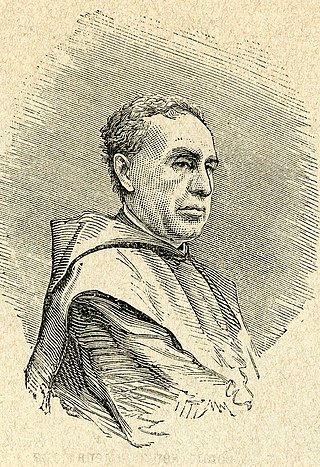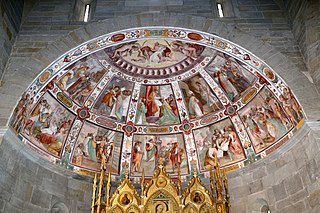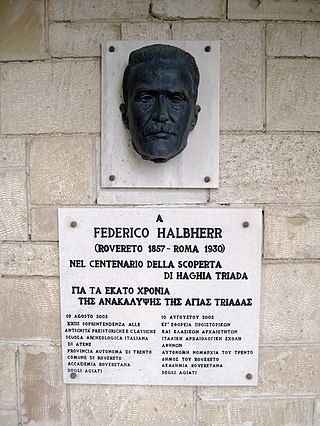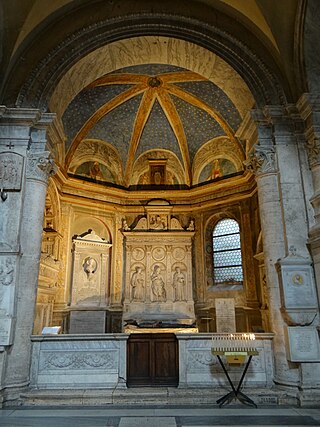Related Research Articles

Domenico Silvio Passionei was an Italian Cardinal of the Roman Catholic Church.

The Collegio Clementino is a palace in Rome, central Italy, sited between the Strada del'Orso and the banks of the Tiber. It was founded by Pope Clement VIII in 1595, to host Slavonian refugees. Giacomo della Porta was commissioned to erect a suitable building to house them, which would be one of the aged architect's last projects. On February 25, 1601, Urban VIII shifted the Slavs to Loreto and refounded the Collegio Clementino as an elite school for young noblemen of every nation and the richest families in Rome. The musical tradition of the Collegio Clementino remained strong: Alessandro Scarlatti wrote oratorios for Carnival seasons and came up from Naples to oversee their production.

The Basilica of Saint Praxedes, commonly known in Italian as Santa Prassede, is an early medieval titular church and minor basilica located near the papal basilica of Saint Mary Major, on Via di Santa Prassede, 9/a in rione Monti of Rome, Italy. The current Cardinal Priest of Titulus Sancta Praxedis is Paul Poupard.
Petronius was bishop of Bologna during the fifth century. He is a patron saint of the city. Born of a noble Roman family, he became a convert to Christianity and subsequently a priest. As bishop of Bologna, he built the Church of Santo Stefano.
Flaminius Annibali de Latera was an Italian historian.
Luigi Lippomano was an Italian bishop and hagiographer.

The Diocese of Viterbo is a Latin Church ecclesiastical territory or diocese of the Catholic Church in central Italy. From the 12th century, the official name of the diocese was the Diocese of Viterbo e Tuscania. In 1986, several dioceses were combined, and the title was changed to "Diocese of Viterbo, Acquapendente, Bagnoregio, Montefiascone, Tuscania and San Martino al Monte Cimino"; in 1991 the name was shortened to "Diocese of Viterbo".

The diocese of Montefiascone was a Catholic ecclesiastical territory in Italy. It was created from the diocese of Bagnorea in 1369. In 1986 was united into the diocese of Viterbo, Acquapendente, Bagnoregio, Montefiascone, Tuscania e San Martino al Monte Cimino. The diocese was immediately subject to the Holy See (Papacy).
Luigi Gaetano Marini was an Italian natural philosopher, jurist, historian, archaeologist and epigraphist.

Luigi Tosti was a Benedictine historian.

The Diocese of Tivoli is a Latin Church ecclesiastical territory or diocese of the Catholic Church in Latium, Italy, which has existed since the 2nd century. In 2002 territory was added to it from the Territorial Abbey of Subiaco. The diocese is immediately exempt to the Holy See.

The Archdiocese of Catania is a Latin Church diocese of the Catholic Church in Sicily, southern Italy, with its seat in Catania. It was elevated to an archdiocese in 1859, and became a metropolitan see in 2000. Its suffragans are the diocese of Acireale and the diocese of Caltagirone.

The Diocese of Conversano-Monopoli is a Latin diocese of the Catholic Church in Apulia. It has existed since 1986, when the diocese of Monopoli was united with the historic diocese of Conversano. The diocese is a suffragan of the Archdiocese of Bari-Bitonto.

Saint Romulus of Fiesole was bishop of Fiesole during the 1st century. He is venerated as the patron saint of Fiesole, Italy. Romulus was probably a local deacon, priest, or bishop of the 1st century.

Federico Halbherr was an Italian archaeologist and epigrapher, known for his excavations on Crete. In particular, he is known for his excavations of the Minoan palace at Phaistos and the Minoan town of Hagia Triada. A contemporary, friend, and advisor of Arthur Evans, he began excavating at Phaistos before Evans began excavating at Knossos. Some of his work was funded by the Archaeological Institute of America.

The Costa or St Catherine Chapel is located in the south aisle of the Basilica of Santa Maria del Popolo in Rome. This is the fourth side chapel from the counterfaçade and was dedicated to St Catherine of Alexandria. The lunettes were painted by the helpers of Pinturicchio and the marble altar-piece is attributed to Gian Cristoforo Romano.

The Polo Museale del Lazio is an office of Italy's Ministry of Cultural Heritage. Its seat is in Rome in the Palazzo Venezia.
Annibale degli Abati Olivieri was an Italian archaeologist, numismatist and librarian, considered the founder of the Biblioteca Oliveriana, Pesaro. An aristocrat without heirs, he was the author of works of archeology and numismatics. He also discovered the site of a Roman sacred grove, the Lucus Pisaurensis at his property on Collina di Calibano in the countryside of Pesaro, at which he unearthed the 13 Votive Stones of Pesaro.
Francesco Maria Torrigio was an Italian ecclesiastical historian and erudite scholar.
References
- 1 2 Kirsch, J.P. (1913). "Pietro Luigi Galletti". In Herbermann, Charles (ed.). Catholic Encyclopedia . New York: Robert Appleton Company.
- Attribution
 This article incorporates text from a publication now in the public domain : Kirsch, J.P. (1913). "Pietro Luigi Galletti". In Herbermann, Charles (ed.). Catholic Encyclopedia . New York: Robert Appleton Company.
This article incorporates text from a publication now in the public domain : Kirsch, J.P. (1913). "Pietro Luigi Galletti". In Herbermann, Charles (ed.). Catholic Encyclopedia . New York: Robert Appleton Company.